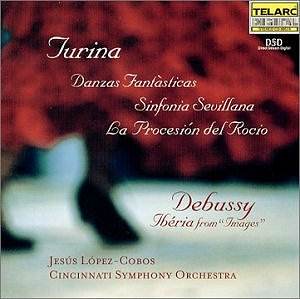 Composer: Claude Debussy
Composer: Claude Debussy
Works: Ibéria from “Images” for orchestra (1905-1908); Joaquín Turina: Danzas Fantàsticas Op. 22 (1920); Sinfonia Sevillana Op. 23 (1920); La Procesión del Rocio Op. 9 (1913)
Performers: Cincinnati Symphony Orchestra; Jesús López-Cobos, conductor
Recording: Music Hall, Cincinnati, Ohio, March 2001
Label: Telarc CD-80574 [64:24]
The works of Claude Debussy and Joaquín Turina present a fascinating intersection of Impressionism and Spanish nationalism, each composer evoking their respective cultural landscapes through a rich palette of orchestral colors and rhythmic vitality. Debussy’s “Ibéria,” which opens this recording, calls forth the vibrant atmosphere of Spain as perceived through a French lens. Written between 1905 and 1908, it reflects the composer’s fascination with the sonic tapestry of the Iberian Peninsula, while Turina’s oeuvre, particularly his Danzas Fantàsticas and Sinfonia Sevillana, channels the folk traditions and festive spirit of Seville, enriching the listening experience with layers of cultural resonance.
The Cincinnati Symphony Orchestra under Jesús López-Cobos presents a mixed bag in this recording, particularly with Debussy’s “Ibéria.” While the orchestra demonstrates technical prowess, the performance does not fully capture the piece’s essential vibrancy and nuance. The opening section, “Le matin d’un jour de fête,” while marked by assured playing, lacks the exuberance one expects from a depiction of festive life. The pizzicato strings, intended to mimic flamenco guitars, are overshadowed by a somewhat intrusive late tubular bell entry, which detracts from the overall buoyancy. This lack of excitement permeates the central movement, “Les parfums de la nuit,” where despite assured execution, the sultry atmosphere of a warm Spanish evening feels elusive.
In contrast, Turina’s works emerge with far greater impact. The “Danzas Fantàsticas,” composed in 1920, are characterized by a lively spirit and rhythmic complexity. The opening “Exaltación” is a testament to Turina’s melodic ingenuity, reminiscent of Manuel de Falla’s influence while remaining distinctly his own. The climactic “Orgia” showcases a dramatic juxtaposition of joy and intensity, revealing the orchestra’s ability to navigate Turina’s vibrant orchestrations with dexterity and flair.
The “Sinfonia Sevillana,” written soon after the Danzas Fantàsticas, is a vivid set of orchestral tableaux that encapsulates the essence of Seville. The opening movement, “Panorama,” unfolds with a mysterious quality that gradually reveals a unifying motto theme, echoing throughout the piece. The central “On the Banks of the Guadalquivir” features a melting violin solo that beautifully evokes the river’s flow, enhanced by the rich timbres of the cor anglais—a moment that captures the listener’s imagination. The finale, “Festival of San Juan Aznalfarache,” is a jubilant celebration, and the orchestra rises to the occasion, delivering a spirited interpretation that contrasts sharply with the earlier Debussy.
La Procesión del Rocio, a work that solidified Turina’s reputation in Spain, brings the recording to a compelling close. Its two-movement structure effectively juxtaposes the vibrant gypsy-inspired festivities with the solemnity of the procession itself. The incorporation of traditional Spanish rhythms and themes creates an evocative atmosphere that resonates deeply, showcasing Turina’s ability to blend national pride with artistic expression.
The recording quality is generally warm and inviting, though at times it sacrifices some brilliance and immediacy, particularly in the brass sections, which could benefit from greater clarity during climactic moments. Despite this, the engineering captures much of the intricate detail in Turina’s orchestration, allowing listeners to appreciate the subtleties in dynamic shading and textural interplay.
This collection serves as a compelling introduction to Turina’s music, revealing a composer whose works deserve more frequent performances in concert halls. While Debussy’s “Ibéria” may not fully ignite in this interpretation, the Cincinnati Symphony Orchestra under López-Cobos emerges as a capable ensemble, particularly in their portrayal of Turina’s vibrant sound world. The juxtaposition of these two composers ultimately highlights the richness of Spanish musical identity and its profound influence on early 20th-century composition.



